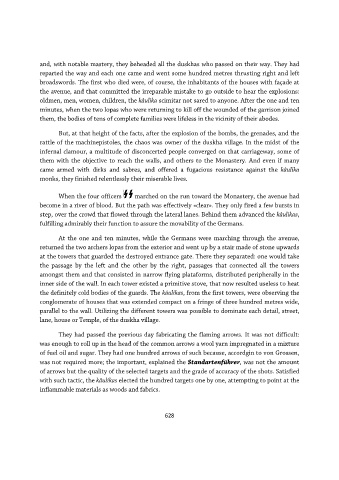Page 628 - Microsoft Word - Belicena respaldo
P. 628
and, with notable mastery, they beheaded all the duskhas who passed on their way. They had
reparted the way and each one came and went some hundred metres thrusting right and left
broadswords. The first who died were, of course, the inhabitants of the houses with façade at
the avenue, and that committed the irreparable mistake to go outside to hear the explosions:
oldmen, men, women, children, the kâulika scimitar not sared to anyone. After the one and ten
minutes, when the two lopas who were returning to kill off the wounded of the garrison joined
them, the bodies of tens of complete families were lifeless in the vicinity of their abodes.
But, at that height of the facts, after the explosion of the bombs, the grenades, and the
rattle of the machinepistoles, the chaos was owner of the duskha village. In the midst of the
infernal clamour, a multitude of disconcerted people converged on that carriageway, some of
them with the objective to reach the walls, and others to the Monastery. And even if many
came armed with dirks and sabres, and offered a fugacious resistance against the kâulika
monks, they finished relentlessly their miserable lives.
When the four officers marched on the run toward the Monastery, the avenue had
become in a river of blood. But the path was effectively «clear». They only fired a few bursts in
step, over the crowd that flowed through the lateral lanes. Behind them advanced the kâulikas,
fulfilling admirably their function to assure the movability of the Germans.
At the one and ten minutes, while the Germans were marching through the avenue,
returned the two archers lopas from the exterior and went up by a stair made of stone upwards
at the towers that guarded the destroyed entrance gate. There they separated: one would take
the passage by the left and the other by the right, passages that connected all the towers
amongst them and that consisted in narrow flying plataforms, distributed peripherally in the
inner side of the wall. In each tower existed a primitive stove, that now resulted useless to heat
the definitely cold bodies of the guards. The kâulikas, from the first towers, were observing the
conglomerate of houses that was extended compact on a fringe of three hundred metres wide,
parallel to the wall. Utilizing the different towers was possible to dominate each detail, street,
lane, house or Temple, of the duskha village.
They had passed the previous day fabricating the flaming arrows. It was not difficult:
was enough to roll up in the head of the common arrows a wool yarn impregnated in a mixture
of fuel oil and sugar. They had one hundred arrows of such because, accordgin to von Grossen,
was not required more; the important, explained the Standartenführer, was not the amount
of arrows but the quality of the selected targets and the grade of accuracy of the shots. Satisfied
with such tactic, the kâulikas elected the hundred targets one by one, attempting to point at the
inflammable materials as woods and fabrics.
628

